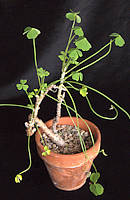Oxalidaceae R. Brown 1818
The Oxalidaceae is a small family of 8 genera and 800 species of dicotyledenous flowering herbs, shrubs and trees from temperate to tropical habitats. The family takes its name from the genus Oxalis which contains the majority of species. The name refers to the accumulation of oxalate in some species, conferring a sour taste. Oxalate poisoning of livestock may occur where pastures are infested with Oxalis.
|
Oxalis Linnaeus 1753
Oxalis is a large genus with over 800 species widely spread in the tropics and temperate regions with the exception of Australasia. Many species come from South Africa and South America. Leaves are alternate and typically divided into 3 - 5 leaflets that undergo marked daily movements, although a few species have simple leaves. The bisexual regular flowers have 5-fold symmetry, with 5 sepals, 5 petals, ten stamens in two rings of five and five styles each with a superior basal ovary. Flowers often close at night or in dull weather and some species e.g. Oxalis acetosella (Wood Sorrel) may produce viable seeds without opening (cleistogamous).
The ovary develops into a 5-chambered fruit which is usually a capsule but may be a berry. Some species have explosively dehiscent fruits as a very effective mechanism for seed dispersal. Seeds may have a fleshy aril that spontaneously inverts itself to catapult the seed from the pod. Because of this, some members of the Oxalidaceae are invasive weeds and may disperse themselves through the greenhouse with volunteer seedlings coming up in every pot. A non-succulent species Oxalis corniculata (creeping wood sorrel), with small yellow flowers, will be familiar to many cactus collectors and is difficult to eradicate.
 A few South American species of Oxalis are stem succulents and some South African species produce small to medium-sized tubers. Some of these tubers are edible and cultivated for food. Leaves can also be eaten. However, excessive consumption of leaves containing oxalate may lead to loss of bone density. Several species have somewhat fleshy succulent leaves.
A few South American species of Oxalis are stem succulents and some South African species produce small to medium-sized tubers. Some of these tubers are edible and cultivated for food. Leaves can also be eaten. However, excessive consumption of leaves containing oxalate may lead to loss of bone density. Several species have somewhat fleshy succulent leaves.
|
 |
Oxalis gigantea Barnéoud 1846
A woody drought-resistant shrub growing up to 20ft tall, but more commonly 6 - 8 ft. Leaves with three obovate leaflets are produced in response to rain. Mature plants produce large yellow 5-petalled flowers in the Spring.
Native to coastal deserts and other dry terrain of Chile. My plant is strictly a Winter grower and is a dry stick through the rest of the year irrespective of watering.
|

 |
Oxalis tuberosa Molina 1782 (Oca, New Zealand Yam)
This perennial plant has succulent stems produce trifoliate leaves which can be eaten in salad, although consumption should be limited because of their oxalate content. The roots produce tubers late in the season in shades of yellow to reddish, purple and black. The tubers allow the plant to survive through Winter frosts that kill the top growth. The small yellow flowers are not self-fertile and require crossing with a different clone. Any seed that is produced is likely to be lost from the self-dehiscent capsules unless precautions are taken.
Oca is cultivated as a crop in the South American Andes but is unknown in nature. However, similar tuberous Oxalis grow in the same region.
|

 Families of Succulent Plants
Families of Succulent Plants 

 A few South American species of Oxalis are stem succulents and some South African species produce small to medium-sized tubers. Some of these tubers are edible and cultivated for food. Leaves can also be eaten. However, excessive consumption of leaves containing oxalate may lead to loss of bone density. Several species have somewhat fleshy succulent leaves.
A few South American species of Oxalis are stem succulents and some South African species produce small to medium-sized tubers. Some of these tubers are edible and cultivated for food. Leaves can also be eaten. However, excessive consumption of leaves containing oxalate may lead to loss of bone density. Several species have somewhat fleshy succulent leaves.





